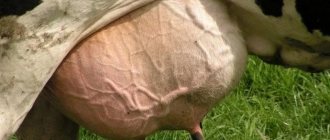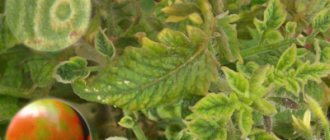Normal temperature readings
Animal owners should know the normal body temperature for each type of cattle. With early diagnosis, it is easier to cure diseases, restore health, and avoid the development of complications.
The temperature will have to be measured; it is difficult to determine its increase by looking at the skin. Cows' skin is always cool. It is important to remember that in the late afternoon the temperature may rise slightly, this is normal.
Standard temperature for domestic artiodactyls:
- females – 38 – 39.5°C;
- males – 38-39°C;
- calves up to 6 weeks – 39-40.2°C;
- up to 2-2.5 months – 39-40°C;
- up to 12 months – 38.5-39.8°C.
If the temperature increases (hyperthermia) even by 1 degree, you should call a veterinarian.
Brucellosis
One of the most dangerous infectious diseases is brucellosis in cows, which can be transmitted from animals to people. Brucellosis is dangerous for people, especially those working on farms:
- veterinarians;
- breeders;
- milkmaids;
- shepherds.
Brucellosis is dangerous for veterinarians Milkmaids Shepherds
Brucellosis is a disease caused by bacteria of the genus Brucella, which mainly affects the nervous, cardiovascular system and skeletal system. Brucellosis bacteria can be stored in water and food for a long time. Brucellosis has different stages of development.
Symptoms of the disease include frequent abortions and stillbirths. To cure brucellosis, a number of antibiotics are used, such as tetracycline, streptomycin, chloramphenicol and others.
Particular attention should be paid to animals during the period after calving. At this time they are vulnerable and may get sick. Temperature must be measured every day.
Other signs of disease
Farmers and veterinarians on large farms do not measure temperatures daily. This is not the most pleasant procedure for cows. Attentive service personnel or farmers can understand from deviations in behavior that the animal is feeling unwell.
The main symptoms of deteriorating health in cows:
- depressed lethargic state;
- unsteady gait;
- cold ears;
- refusal to eat;
- muscle tremors (cramps).
If such signs are observed, then you need to measure the temperature and call a veterinarian. Self-medication is dangerous for animals; examination by a specialist is necessary.
Signs and treatment of dangerous diseases in calves
Also check out these articles
- Tomato variety Gazpacho
- Guinea fowl breeding
- Vidnaya pear variety
- Fodder beet
Dangerous diseases of calves, also known as infectious diseases, should either be prevented in advance or treated urgently. Their main cunning is their rapid spread. In a matter of days, the entire herd can become infected, not to mention the young animals!
- Cryptosporidiosis occurs when a pathogenic bacterium enters an animal's stomach. Usually leads to death. Symptoms appear on day 3: weakness, diarrhea, teeth grinding, loss of appetite. Treated with antibiotics.
- Colibacillosis (Esherichiosis or white diarrhea) develops from the first days of life. Caused by a special type of Escherichia coli. The body is quickly depleted and within 3-5 days the calf may die. Symptoms: light, liquid stool with blood, decreased appetite, increased body temperature. Treatment: individuals drink strong tea, castor oil, chamomile decoction according to the veterinarian’s prescription, and a remedy such as Acidophilus also helps.
Important! At the first sign of an illness, you need to call a veterinarian, because if the disease is infectious, you can lose all the calves and even a herd of cows!
Read also: How to get rid of hornets under the roof of your house
- Coronavirus enteritis occurs when a specific virus enters the body. Week-old calves often get sick. The infection is transmitted through care items, food, bowls, water, etc. Mortality rate is up to 50%. Symptoms: bloating, green diarrhea, mouth ulcers, weakness, depression. They are treated with serums prescribed by a veterinarian, but it is easier to prevent the disease by vaccination.
- Pasteurellosis is difficult to treat because it is difficult to diagnose. Calves usually die from it within 2-7 days. Symptoms: diarrhea, exhaustion, cough, swollen joints, hemorrhage in the trachea.
Choosing a thermometer
As with humans, conventional measuring instruments are used for animals - thermometers.
Two types of thermometers are used:
- Mercury thermometers. They are made of glass and contain mercury compounds inside. To measure the temperature, you need to hold the thermometer in the rectum for 6 to 8 minutes.
- Electronic thermometers. They are more convenient to use, the readings are displayed on a small screen. Time spent in the rectum is from 30 seconds to 1 minute.
There is one way to measure the temperature of animals - a thermometer is inserted into the rectum. This is not the most pleasant procedure for animals. Cows have to be calmed and restrained, but there is no other method.
It is better to use an electronic measuring device. It will not crack as it is made of plastic. It will also show results faster and be safe in case of mechanical damage. This thermometer has one drawback - its high price.
Temperature measurement process
For any type of thermometer, the measurement process will be the same. It involves several stages:
- Disinfecting the thermometer. Before the procedure, the measuring device must be wiped with a sterile cotton swab, which is moistened with an alcohol solution (70%).
- Lubrication. Vaseline or any safe lubricant is suitable for this. This will irritate the rectum less and not disturb the animal.
- Inserting the thermometer inside. The lubricated thermometer must be inserted rectally to a depth of 2-3 cm forward with the measuring element.
- Time delay. It is necessary to hold for a certain time for each type of device, while calming the animal.
- Removal and disinfection of the thermometer. The thermometer is slowly removed, the readings are determined, and cleaned with a soap solution. Then they are disinfected with an alcohol solution (70%). In this way, the risk of transmitting diseases to subsequent animals is reduced.
If there is a need to measure the temperature every day, then purchase a special thermometer for cows at a pet store. In females, you can insert a thermometer into the vagina. But we must remember that such measurements will not always be correct. During estrus and after birth, they will be different.
How to measure
A cow's body temperature normally ranges from 38 to 39°C, but some discrepancies occur. In the animal world, there are species whose norm may differ significantly from the accepted one. It can be determined only after consultation with a doctor, who will find out whether the animal has a particular ailment and tell you what to do.
Separately, it is necessary to discuss the calf norm. What temperature is considered comfortable for him? In this case, a high rate is considered only a physiological feature. Depending on the age, the normal temperature of the baby fluctuates as follows:
- age up to 5-6 weeks - 38.5-41°C;
- age up to 2 months - up to 40.2°C;
- up to a year - up to 40°C.
Afterwards, these figures can already be considered a deviation. A cow's body temperature is measured with a regular animal thermometer, which can be purchased at any pet store for a small amount. To most accurately determine t, an animal thermometer is inserted into one of the holes of the cow. Using other options does not give accurate results. Temperature checks mainly occur through the vagina, but in this case there are some nuances. Thus, the result may differ significantly when measured on a normal day and when measured after calving and during estrus. During pregnancy and during estrus, the numbers on the thermometer may be significantly higher than usual. That is why it is important to know what the normal temperature of cows is.
Safety rules when measuring temperature
Pets don't like having their temperature taken. While a cat can be dealt with, a cow can seriously injure a person. It is necessary to observe certain safety measures so as not to risk your health when measuring your temperature. You cannot measure the temperature alone; there should always be an assistant. The procedure is unpleasant for animals and their behavior is difficult to predict. One person should insert the thermometer into the anus, and the other should fix the animal.
It is better to approach the animal from the side, so it will be more difficult for him to kick. You must first put on rubber gloves, although they are not very comfortable. They glide over the cow's fur, but protect against infection.
It is necessary to secure the cow well, especially the bull. Even the calf must be secured in the stall before the temperature is measured. The animal may behave aggressively. Sometimes even two employees find it difficult to cope. It is better if the animal stands with its horns against the fence and one side leaning against the wall. You can consult your veterinarian. He may have his own methods of restraining the animal.
Reasons for rising temperature
There are many reasons for rising temperatures. This is often a symptom of illness. Some of them are dangerous and can lead to the rapid death of the entire herd, so you should urgently contact a veterinarian.
An increase in temperature may be associated with poor animal care. In this case, additional signs are not detected.
The veterinarian examines the cows and determines the disease. But farmers need to imagine what pathologies they might be talking about. When body temperature increases, the following problems are suspected:
- poor nutrition;
- poisoning;
- difficulties in recovery after calving;
- infectious diseases.
If the temperature has risen slightly, this indicates a sluggish form of the inflammatory process. If it rises to 41°C or more, the veterinarian will confirm the acute phase of the disease.
Poor nutrition
A slight increase in temperature occurs as a result of using low-quality feed. Pathological bacteria can multiply in rotten root crops and rotted hay. They spread quickly in the digestive system of animals, causing inflammation of the mucous membrane. This problem exists in farms that skimp on good feed for the sake of profitability.
Poisoning
A domestic cow is not able to determine the quality of food, so it can eat toxic substances. They get into feed accidentally, for example, on pastures through fertilizers, when spraying chemicals and from poisonous plants. In case of poisoning, the following symptoms are associated with fever:
- diarrhea;
- uncharacteristic behavior;
- convulsions;
- limb failure;
- general lethargy, passivity.
The organism of artiodactyls is sensitive to toxic substances. In just a few hours the animal may die. If you observe such signs, you should immediately contact a veterinarian.
Important! Animals can become poisoned by eating potatoes from the previous harvest that have turned green in the sun. This vegetable should not be fed to cows after prolonged storage.
Complications after calving
After the birth of a calf, the cow’s body is weakened, takes a long time to recover and is often susceptible to various diseases. At this time, the animal may experience various health problems, which will be signaled by an increase in temperature. Among the complications, retention of the placenta, trauma and infection of the birth canal, as well as a birth cut are more common. With such pathologies, body temperature decreases.
After calving, experts recommend measuring the cow's body temperature daily. This will allow you not to miss the time of development of the disease. For example, if the placenta is retained for only a day, you must urgently call a veterinarian. Otherwise, tissue decomposition will occur in the uterus, and infection will begin, which will spread to all internal organs.
Infectious infection
An infection entering the body is always accompanied by an increase in temperature. Fever protects the immune system from viruses. Many inflammatory processes will also occur with hyperthermia.
Fever is a symptom of the following infectious diseases:
- infectious lesions of the udder;
- leptospirosis;
- plague;
- endometritis;
- pneumonia;
- leukemia;
- foot and mouth disease;
- brucellosis;
- mastitis;
- hoof diseases.
Such pathologies are dangerous and can kill many animals, so you should urgently call a doctor.
First aid for fever
What to do if your calf has a fever? Fever is evidence that an inflammatory reaction is occurring in the calf’s body. This may be the body’s response to the invasion of pathogenic bacteria or other microorganisms, or it may also be non-infectious in nature. Sometimes an increase in temperature is accompanied by metabolic disorders resulting from poor nutrition.
In the case of infectious diseases in a calf, fever serves a protective function. It enhances the production of substances necessary to fight infection.
Once a diagnosis is made, veterinarians usually prescribe a course of antibiotics. Correctly selected treatment will lead to a natural cessation of fever.
There is a danger only if it lasts too long, overloading the calf's body. For this purpose, there are antipyretics, which also have anti-inflammatory and anesthetic effects.
Reasons for the drop in temperature
In some cases, the body temperature of adults or calves decreases. This does not happen often, but farmers should be aware of it. Cow behavior is changing. Animals become lethargic or, conversely, begin to show anxiety and moan protractedly.
A decrease in temperature (hypothermia) is dangerous for cows; their condition must be carefully considered. Often it is poisoning with toxic substances that causes hypothermia. This happens after eating poisonous plants and mushrooms. Animals urgently require treatment; you must quickly call a veterinarian.
Hypothermia is characteristic of vitamin deficiency in calves. This can be corrected by increased doses of vitamin preparations, changes in diet, and increased duration of walks in the fresh air. Also, a decrease in body temperature in young animals can occur due to hypothermia. To correct this situation, it is necessary to provide the animals with a warm barn, high-quality bedding and eliminate the possibility of drafts.
A maternity cut is considered a serious illness with a symptom of hypothermia. The cow experiences paralysis of the limbs, tongue and pharynx. If the animal is not treated, it will die within a few days. You cannot treat a cow on your own; you must immediately seek help from a specialist.
Low temperature in a cow
When hypothermia occurs, the behavior of livestock changes dramatically: it becomes weak or overly active and restless. In addition, the cow mooes constantly and for a long time.
Causes
Why does a cow's temperature drop?
- Intoxication of the body as a result of eating poisonous mushrooms and plants while walking independently in pastures.
- In young animals, hypothermia occurs due to a lack of nutrients, as well as severe hypothermia.
- In the presence of postpartum paresis, which is accompanied by paralysis of the pharynx, intestines, as well as the tongue and limbs. In addition, at an advanced stage the animal loses consciousness. In the absence of timely treatment, cattle die within a couple of days.
How to increase
If hypothermia does not threaten the life of the animal, then the cow is warmed with the help of pillows, blankets and special heating pads. In addition, the cattle are placed on warm and clean bedding.
However, if there are other clinical signs that indicate specific pathologies, call a veterinarian immediately. The veterinarian prescribes flushing the kidneys with warm saline solution.
Ways to reduce high fever
After diagnosis and diagnosis, the veterinarian prescribes treatment. It is carried out in a complex. Antibiotics, antipyretic and hormonal medications, as well as vitamin complexes are often immediately prescribed.
Effective means for reducing high fever are:
- Polyflex. This is an analogue of ampicillin for use in veterinary medicine. It is administered intramuscularly 1 time per day. The duration of the course depends on the severity of the disease.
- Penicillin. This is an artificial analogue of a natural antibiotic. It is administered orally 4 to 6 times a day. The duration of the course depends on the severity of the pathology.
- Antipyrine. This is a complex drug, similar in structure to salicylic acid. It is administered in the oral cavity at 10-15 g per day. The duration of the course is determined individually.
Important! All antipyretic drugs reduce pain and reduce inflammation. In this case, the veterinarian must monitor the animal’s condition.
Characteristics of common diseases of young cattle
Timely veterinary care allows not only to cure diseases of calves, but also prevents the death of young animals from the most dangerous diseases. The creation of a highly productive herd depends on maintaining the health of calves; special attention should be paid to this identification and treatment of various animal diseases, starting from the first days of their life.
Diseases of calves
Animals can be affected by contagious and non-contagious diseases of various etiologies. Each of them has its own causes and symptoms. Diseases of calves are treated with the help of various medications and products prepared from medicinal herbs and other substances. Non-communicable diseases do not require quarantine measures, unlike contagious diseases, which are dangerous due to the scale of their damage.
Health pathologies of newborn calves and young animals can be divided into:
- Respiratory diseases that affect the animal's respiratory organs (bronchopneumonia).
- Intestinal diseases associated with the functioning of the digestive organs (gastroenteritis, colibacillosis, dyspepsia, rickets, tympania).
- Eye diseases: conjunctivitis, corneal inflammation, keraconjunctivitis.
- Other diseases (cutaneous gadfly, paratyphoid fever, white muscle disease).
The most common diseases of young cattle are described below.
White muscle disease
This disease is often called muscular dystrophy. This pathology is characterized by metabolic disorders (mineral, protein, carbohydrate), leading to various changes in skeletal and cardiac muscles. Most often it manifests itself in the first days of life of calves during the cold season.
More than half of the young animals die from this disease, and the animals that have recovered from the disease lag behind in development.
Reasons: lack of selenium in feed, inadequate feeding, lack of minerals and amino acids, poor living conditions.
Symptoms: depressed state, weakness, muscle tremors, abnormal movements, paralysis and convulsions of individual parts of the body, pallor of the mucous membranes, rapid and shallow breathing, developmental delay.
Therapy: taking selenium, tocopherol, sulfur-containing amino acids, protein hydrolysates and trivitamin.
Preventive measures: administration of selenium and tocopherol to pregnant cows.
Gastroenteritis
This pathology occurs when there is a digestive disorder caused by eating low-quality feed and drinking contaminated or sour milk. Gastroenteritis is caused by greedy drinking of calves and switching to other feeds.
Signs: prolonged diarrhea.
Treatment:
Prevention of gastroenteritis involves eliminating the causes that can cause indigestion.
Paratyphoid
This disease often affects newborn calves under poor housing conditions (dampness, dirt, poor air ventilation) . It is caused by paratyphoid bacillus.
At the initial stage, the disease is practically asymptomatic. A week later it takes on an acute form. At the same time, the calf’s temperature rises to 41 °C, appetite is lost, and breathing and pulse rates increase. In some cases, paratyphoid fever is accompanied by bloody diarrhea. If measures are not taken in a timely manner, the disease leads to the death of the calf.
Therapy: mild forms of the disease are cured in 7-14 days. During therapy, sick calves are injected with antiparatyphoid serum, biomycin, furazolidone, biovetin, and a specific bacteriophage are used. Sick animals are kept separately from others.
Prevention: ensuring normal conditions for keeping animals, using acidophilus, propomycelin.
Bronchopneumonia
This disease often occurs in calves in the first month of life. It affects animals kept in damp rooms with poor ventilation. Keeping a calf on the floor without good bedding leads to bronchopneumonia. It affects animals with vitamin deficiency and insufficient walking.
Most often, this pathology occurs during the cold season.
Signs: heavy breathing, discharge from the nose and eyes, cough, fever up to 40-42 °C. In some cases, the disease is accompanied by diarrhea.
Therapy: bronchopneumonia is treated with special medications (antibiotics, sulfonamide drugs). Sick calves are kept separately from healthy ones.
Prevention: creating optimal living conditions for animals, good care and feeding.
Colibacillosis
This pathology is often called white diarrhea. This acute infectious disease most often affects calves in the first month of life. The causative agent of colibacillosis is E. coli, which enters the body from dirty dishes, equipment or when licking the walls of the barn. Calves from 1 day of life to 8 months are susceptible to the disease.
Symptoms: loss of appetite, fever, yellowish diarrhea, sudden weight loss, weakness. Over time, the temperature drops to 32-34°C. With colibacillosis, the probability of death of the animal is high. Recovered calves are noticeably delayed in development.
Therapy:
- the animal is given castor oil to cleanse the stomach;
- instead of milk, the calf is given strong tea 1-2 times;
- Acidophilus is fed to the sick animal. In this case, the dose is increased daily by 50 g. They start with 50 g/day, and by the age of one month the amount is increased to 1.5 kg/day;
- taking bacteriophage, anti-colibacillosis serum, caffeine, tannin, tanalbin;
- To reduce pain, give a chamomile decoction.
Prevention of colibacillosis: compliance with the rules of care and hygiene, feeding newborn calves colostrum containing substances that improve immunity.
Dyspepsia
This pathology is one of the most common diseases of the digestive system. It is accompanied by indigestion and dehydration. The main reasons: violation of care rules, improper feeding of cows, untimely feeding of colostrum.
Signs of dyspepsia: loss of appetite, poor drinking, pale mouth and nasal cavity, diarrhea, lethargy.
A sick calf often licks the walls of the barn. Treatment consists of reducing the dose of feed and reducing the amount of colostrum consumed. The calf is given only the best hay and a 1% salt solution. Dairy calves are given milk and boiled water (1:1) 1-2 times a day.
In case of severe diarrhea, the animal is given a decoction of oak or yarrow bark and raw egg whites. If veterinary care is not provided in a timely manner, the calf may die.
Prevention: drinking decoctions of medicinal plants such as yarrow, St. John's wort, elecampane, peppermint.
Rickets
Rickets is a pathological condition of the body that can occur in young animals due to vitamin D deficiency . It leads to disruption of phosphorus-calcium metabolism, which often causes deformation of the animal’s skeleton. Rickets appears in calves that do not walk much or are kept in a dark and damp barn.
Signs: slower growth, curvature and thinning of bones.
Therapy consists of using therapeutic doses of vitamin D, fish oil, salt, bone meal, and chalk.
Prevention of rickets consists of regular intake of the above substances and yeast feed, as well as improving the living conditions of young animals.
Tympany
This disease is also called bloat. Tympany occurs in calves after 1.5-2 months of life. Its reasons are different. Most often it appears when animals are switched to succulent and roughage feed. Bloating can occur when eating low-quality root vegetables (frozen, moldy), very juicy grass, and concentrates.
Symptoms of tympania: swelling of the left side, shortness of breath, poor appetite. Treatment:
- massage the left side of the calf with a fist until gas and belching appear;
- a sick calf is given 100-150 g of vegetable oil or castor oil;
- drinking 0.5-1 liters of fresh milk;
- the animal is taken out for a walk in the yard, where it must move for at least 0.5 hours.
In particularly severe cases, the veterinarian inserts a special probe into the calf’s esophagus or punctures the scar with a trocar.
Prevention of tympania: limiting visits to alfalfa pastures that are covered with dew or rainwater on the grass. You cannot give the animal water immediately after eating concentrates and green food.
Bezoar disease
This disease affects calves in the post-colostrum and weaning period. Bezoar disease is manifested by the formation of lumps (bezoars) in the abomasum of an animal, consisting of wool, plant fibers, and casein protein.
Reasons: violation of the technology of feeding and keeping animals, lack of movement, metabolic disorder. Bezoars often lead to inflammation of the mucous membrane and intoxication.
Treatment: taking medications that provide the body with minerals, proteins and vitamins, as well as drugs that improve digestion processes.
Dangers of Heat
Reducing high temperature is a necessary process, but not the most important one. We need to find out the cause and get rid of the disease. Having solved a problem with one symptom, you cannot stop. After the temperature drops, the cow’s condition may worsen, because the immune system fought the spread of pathogenic microorganisms by increasing the temperature.
The veterinarian prescribes treatment, which must be strictly followed. The animal cannot complain of being unwell, so it will not be possible to objectively assess its condition. For this reason, the farmer must strictly adhere to the veterinarian’s instructions and be sure to complete the entire course with the animal without stopping treatment.
If a cow has a high temperature for a long time, this leads to an acceleration of metabolism and the functioning of systems and internal organs is disrupted. At the same time, toxic substances are poorly removed, which negatively affects the condition of the body.
Consequences of increased performance
Reducing a cow's body temperature does not mean solving health problems. Inexperienced farmers lose sight of the fact that it is the cause that needs to be dealt with, not the consequences. Sometimes, by lowering body temperature, you can provoke a deterioration in your general condition, because sometimes by increasing the temperature and strengthening the immune system, the body tries to remove viruses or bacteria that have penetrated it. It is the high temperature that prevents the proliferation of bacteria and helps eliminate pathogens and infection.
Consultation with a doctor is essential. A person should not allow rash actions, so as not to worsen the condition of the animal. If body temperature differs from the norm over a long period of time, consequences such as acceleration of metabolism may appear, which will only lead to disruptions in the functioning of internal organs and disruption in the neutralization of harmful substances. The latter include not only spoiled food, but also products left in the body by harmful microorganisms, the remains of already dead parasites, the removal of which is not only necessary, but also mandatory. The listed factors only once again prove that only a doctor can correctly measure and reduce fever.
Low temperature rise
When low body temperature is not life-threatening, cows can be kept warm using blankets and heating pads. The cow can be placed on a warm bedding. It’s another matter if there are symptoms that indicate the animal’s serious condition. Then you need quick help. Dialysis with warm saline is used to quickly raise body temperature.
Prevention measures
It is difficult to prevent fever in artiodactyl domestic animals. Preventive measures will consist of following the rules for keeping cows, fulfilling hygienic requirements for barns, and preventing drafts and hypothermia in adult animals and young animals.
You should carefully monitor the nutrition of cows and prevent poisonous herbs, fertilizers, and toxic substances from getting into pastures and meadows with fodder grass. Before distributing root crops, they must be examined to identify rot and other damage. It is necessary to monitor the condition of the udder and hooves, and carry out preventive treatment.
The condition of animals must be closely monitored during pregnancy and after birth. You need to know that sometimes the temperature may differ from the norm, but the animal will feel well and there will be no signs of illness. This is an individual feature of the body, it is recorded by a veterinarian. When measuring temperature, this fact must be taken into account.
When to monitor the thermometer readings
In case of any suspicious condition of the animal, it is necessary to use a thermometer. If the animal is already susceptible to any serious illness, its temperature should be monitored for 10-15 days. In the first month after calving, daily monitoring is necessary (including for the calf) with regular recording of indicators.
A temperature graph will help you notice in time even a short jump in a cow’s body temperature, which will make it possible to prevent or much more easily cure a pathology that will not manifest itself again. This may be a hidden infection, postpartum complications or nutritional disorders.
Any deviations from normal temperature should be reported to your veterinarian immediately. Timely professional inspection and early diagnosis often saves time, money and protects the health of livestock.











